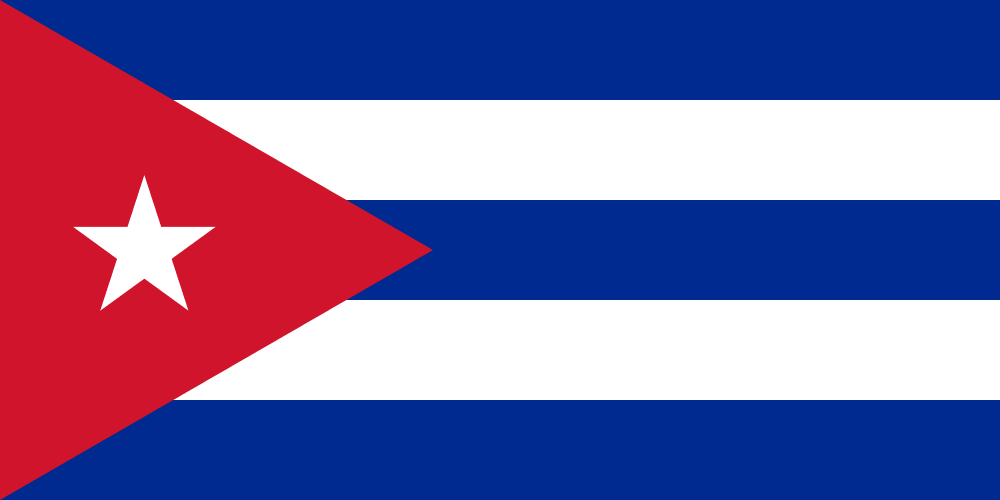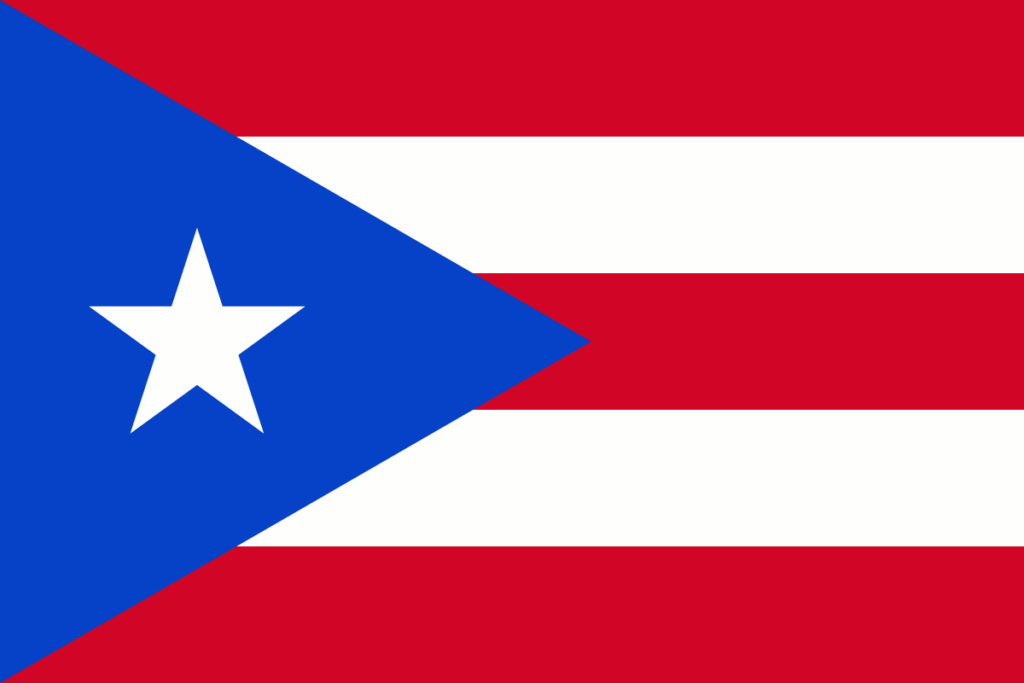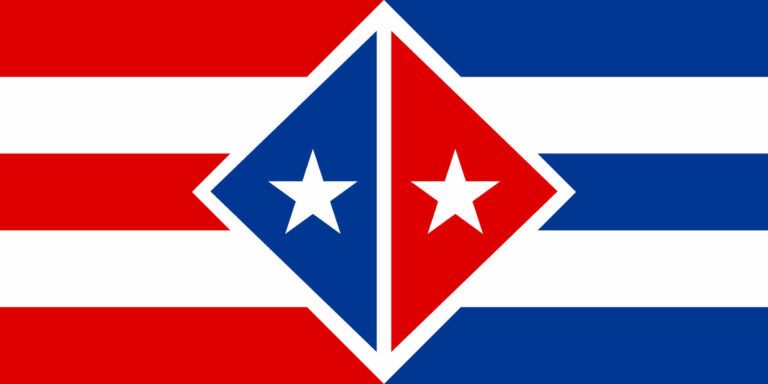The Puerto Rico flag is similar to the Cuban flag with a few changes. The only difference being the coat of arms in the center. The Puerto Rico Flag has the coat of arms that consists of a radiant Chief and six stars representing the five administrative regions, plus the capital region, that are commonwealths.
History of the Cuban Flag
The Cuban flag was designed by Francisco de Paula Santander, a Cuban general, in 1849. The flag was used during the Cuban War of Independence and was later adopted as the official flag of Cuba.
The Cuban flag is the national flag of Cuba. The current design was officially adopted on May 19, 1902. The Cuban flag is composed of three equal horizontal stripes (white, blue, and red) with a large yellow star in the middle. The Cuban national anthem, La Bayam de Cuba, is played every time the flag is hoisted. The Cuban flag was inspired by the Roman-Dutch Tricolour, an unofficial flag of the Dutch Republic. The Roman-Dutch Tricolour was a tricolor of yellow, white, and blue, and the Dutch Republic used it during the Dutch Revolt, a revolt against Spanish rule. The yellow represented the Netherlands, the blue represented the Mediterranean Sea, and the white represented the lands of the Dutch, who had been freed from the domination of the Spanish during their rule.

The Cuban flag was designed in 1849 by José Martínez and is composed of three equal horizontal stripes: white, blue, and red. The Cuban national anthem, La Bayam de Cuba, is played every time the flag is hoisted. The Cuban flag was created in 1849 and was used until it was changed to the current flag in 1961.
History of the Puerto Rico Flag
The Puerto Rican flag was designed in 1868 by Francisco Martínez del Mazal, a Puerto Rican Revolutionary Committee member. The flag’s original design featured a blue background representing loyalty to the Union, a golden eagle symbolizing freedom, and 13 alternating white and red stars representing the 13 original colonies. The colors were changed to blue, white, and red in 1873, at the suggestion of Dr. Blas T. Torres, in honor of Puerto Rico’s first governor, General Juan Ponce de León. The current design was adopted in 1897 after the United States Congress established a separate flag for Puerto Rico.

The Puerto Rican flag was first flown in 1897, years before the United States flag, during Puerto Rico’s first independence celebration. The Puerto Rican flag is a blue flag with a gold Puerto Rico coat of arms. The design is based on the flags of Cuba and the United States, which were used as sources of inspiration by the Puerto Rico independence movement and the Puerto Rican Revolutionary Army, respectively. The blue color symbolized Puerto Rico’s loyalty to the Union, while the use of the stars as opposed to the Stars and Stripes demonstrated Puerto Rico’s desire for self-governance.
Differences and Similarities
The Puerto Rican flag is a unique flag deeply rooted in tradition. The Puerto Rican flag is very similar in design to the Cuban flag. Both flags are red and in the middle is a blue circle with a white star. The circle is called the canton and is where the colors of the Puerto Rican flag are represented.
The Puerto Rican Flag and the Cuban Flag are known for their orange color. This color is based on the Spanish flag, which used the color orange to symbolize the downfall of the Muslim Empire of Cordoba. Over time, the color orange became associated with the Spanish Royal family and was used as a sign of rebellion against their rule. During the American Revolution, the colonists used orange as a sign of resistance against the British.
The Puerto Rican flag and the Cuban flag are both very different flags. The Puerto Rican flag is red, and the Cuban flag is also red, but it is made up of several different colors. The Puerto Rican flag is essentially the same as the Cuban flag, but it was designed later. The Puerto Rican flag was based on the Cuban flag, but it was redesigned later to have a more symbolic meaning.
The Puerto Rican flag is distinctively different from the American flag. In the United States, the flag symbolizes liberty, freedom and the nation itself. On the other hand, the Puerto Rican flag is a symbol of nationalism, and it was originally used as a symbol of Puerto Rican independence.
Representation of the Flags
What does the flag of both Puerto Rico and Cuba represent? The Puerto Rican flag is unique in that it is a symbol of both Puerto Rican nationalism and independence. The colors blue, white and red are the colors of Puerto Rican independence. These colors were chosen to represent the ideals of liberty, freedom and equality. The star in the blue canton symbolizes Puerto Rico’s status as the first Spanish territory in the New World.
The colors of the Puerto Rican flag stand for the three main island groups that make up Puerto Rico: the Puerto Rican people, the Island of Puerto Rico and the sky. The blue represents the Puerto Rican people, the white represents the Island of Puerto Rico, and the red represents the sky. The red stripes also represent the blood that was shed in pursuit of Puerto Rican independence.
The Cuban flag is a horizontal tricolor of blue, white and red. The colors are the Pan-American colors, and they have meaning in the history of Cuba and in the struggle for Cuban independence. The blue symbolizes Cuba and the Caribbean, the white represents peace and neutrality, and the red represents Cuban nationhood. The flag was originally adopted in 1879, before the revolution, and was known as the Flag of the Ten Cities.
Puerto Rico’s flag is red, white and blue, just like the United States flag. But unlike the flag of the United States, the Puerto Rican flag also has a red circle with a white star in the upper left corner. The red circle with the white star is known as the Cuban flag. The Cuban flag was used by Cuban patriots in the 19th century as inspiration for Puerto Rico’s current flag design.
Why are Cuba and Puerto Rico flags the same?
Eventually, that flag was designated as the official flag of Cuba in 1903. The blue in all those Cuban flags was Navy blue, so it stands to reason that when the flag of Puerto Rico was adopted in 1895 (with the colors of the Cuban flag inverted), the triangle’s shade of blue was dark (Navy).
Reason Why Both Countries Have A Similar Design
In 1849, Narciso López designed the Cuban flag. The Puerto Rican Section of the Cuban Revolutionary Party, founded by Jose Marti, agreed to use the Cuban flag as the model for the Puerto Rican flag. The blue in all those Cuban flags was Navy blue, so it stands to reason that when the flag of Puerto Rico was adopted in 1895 (with the colors of the Cuban flag inverted), the triangle’s shade of blue was dark (Navy). The design for the Puerto Rican flag was adopted by a committee of exiles living in New York during the mid-1890s.
Later, the flag of Puerto Rico was designed by Dr. Ramón Emeterio Betances in 1868. The origins of the current flag of Puerto Rico, adopted by the Commonwealth of Puerto Rico in 1952, can be traced to 1868, when the first Puerto Rican flag, “The Revolutionary Flag of Lares,” was conceived by Dr. Ramón Emeterio Betances and embroidered by Mariana “Brazos de Oro. Later, a bill known as Law 53 of 1948, better known as the Gag Law, made it a felony to own or display the Puerto Rican flag. José Martí used the flag of the Cuban as a case study in designing theirs.
What flag is Puerto Rico but opposite?
The flag of Puerto Rico is a symbol of the island’s unique cultural identity and political history. It features a blue triangle with a white star in the center, surrounded by alternating red and white stripes. The blue triangle represents the three branches of government in Puerto Rico, while the white star stands for the island’s Commonwealth status.
However, when it comes to the question of what flag is Puerto Rico but opposite, one might think of the Cuban flag. The Cuban flag also features a blue triangle, but it is situated on the left-hand side of the flag and has a white star on it. The Cuban flag also has red and white stripes, but they are horizontal rather than vertical. Both flags are rich in symbolism and reflect the complex histories and identities of their respective nations.
What is the difference between Puerto Rico and Cuba flags?
The Cuban flag has five horizontal stripes of blue and white. The red triangle and white five-pointed star are in the center. The flag of Puerto Rico is just the opposite. The three blue stripes represent the three departments into which Cuba was divided at that time.
Did Puerto Rico copy the Cuban flag?
The Cuban flag came first when it was designed in 1849 by Narciso López. Later, the flag of Puerto Rico was designed by Dr.Ramón Emeterio Betances in 1868.
Does Puerto Rico have 2 flags?
Yes, Puerto Rico does have two flags – the official flag and the unofficial “Boricua” flag. The official flag of Puerto Rico is the one recognized by the government and used in official settings. As previously mentioned, it features a blue triangle with a white star in the center, surrounded by alternating red and white stripes. The Boricua flag, on the other hand, is an unofficial symbol of Puerto Rican pride and identity.
It features a similar design to the official flag, but with the blue triangle and white star replaced by a sun with a human face, surrounded by a rainbow of colors. The Boricua flag is often used in cultural and sporting events and as a symbol of Puerto Rican nationalism. While not officially recognized, it holds significant cultural and historical significance for many Puerto Ricans both on the island and in the diaspora.
How are puerto rico and cuba different
Puerto Rico and Cuba are two distinct Caribbean islands with their own unique histories, cultures, and political systems. One of the most significant differences between the two is their political status. While Puerto Rico is a United States Commonwealth, with a limited degree of self-governance, Cuba is a socialist state with a one-party political system. Another notable difference is in their economies – Puerto Rico is a relatively affluent island with a diversified economy that is heavily influenced by its relationship with the United States, while Cuba’s economy has historically been reliant on agriculture and has faced significant challenges due to its isolation from much of the world.
Culturally, Puerto Rican and Cuban traditions share many similarities, such as a love for music, dance, and vibrant cuisine. However, each island also has unique cultural traditions and expressions, shaped by their respective histories and demographics. Overall, while there are some similarities between Puerto Rico and Cuba, each island is distinct and worthy of exploration in its own right.



1 Comment
Pingback: Puerto Rico Flag: facts about the origins and meaning